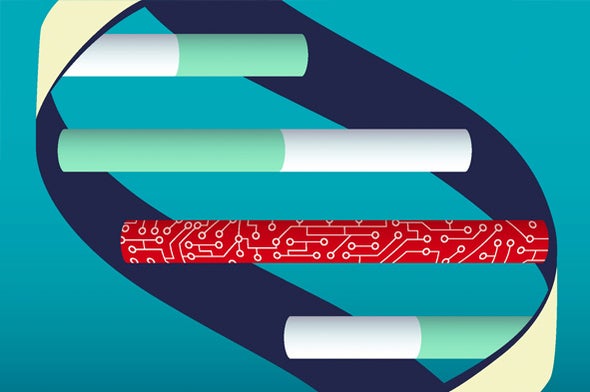How Has Dna Technology Changed The Way That Classification Is Done?
DNA Information Storage Is Closer Than You Think
Life's information-storage system is being adapted to handle massive amounts of information

Every minute in 2018, Google conducted 3.88 one thousand thousand searches, and people watched iv.33 million videos on YouTube, sent 159,362,760 e-mails, tweeted 473,000 times and posted 49,000 photos on Instagram, according to software company Domo. By 2020 an estimated ane.7 megabytes of data volition be created per second per person globally, which translates to near 418 zettabytes in a unmarried year (418 billion one-terabyte hard drive'southward worth of information), assuming a world population of 7.8 billion. The magnetic or optical data-storage systems that currently hold this volume of 0s and 1s typically cannot last for more than a century, if that. Further, running data centers takes huge amounts of energy. In short, we are about to take a serious data-storage trouble that volition only become more severe over time.
An culling to hard drives is progressing: DNA-based data storage. DNA—which consists of long chains of the nucleotides A, T, C and Yard—is life's information-storage fabric. Data can be stored in the sequence of these letters, turning DNA into a new form of information technology. It is already routinely sequenced (read), synthesized (written to) and accurately copied with ease. Deoxyribonucleic acid is as well incredibly stable, every bit has been demonstrated by the complete genome sequencing of a fossil horse that lived more than 500,000 years ago. And storing it does non crave much energy.
Just it is the storage capacity that shines. Deoxyribonucleic acid tin can accurately stow massive amounts of data at a density far exceeding that of electronic devices. The uncomplicated bacterium Escherichia coli, for instance, has a storage density of about x19 bits per cubic centimeter, co-ordinate to calculations published in 2016 in Nature Materials by George Church building of Harvard University and his colleagues. At that density, all the world's current storage needs for a year could be well met past a cube of Dna measuring well-nigh one meter on a side.
The prospect of DNA data storage is not merely theoretical. In 2017, for instance, Church'southward grouping at Harvard adopted CRISPR Dna-editing technology to tape images of a human being hand into the genome of E. coli, which were read out with higher than ninety percent accuracy. And researchers at the University of Washington and Microsoft Research have adult a fully automated system for writing, storing and reading data encoded in Dna. A number of companies, including Microsoft and Twist Bioscience, are working to advance Dna-storage technology.
Meanwhile DNA is already existence used to manage information in a dissimilar way, by researchers who grapple with making sense of tremendous volumes of information. Contempo advancements in adjacent-generation sequencing techniques allow for billions of DNA sequences to be read easily and simultaneously. With this ability, investigators tin employ bar coding—utilize of Deoxyribonucleic acid sequences every bit molecular identification "tags"—to proceed track of experimental results. Deoxyribonucleic acid bar coding is at present being used to dramatically accelerate the pace of research in fields such as chemical technology, materials science and nanotechnology. At the Georgia Institute of Technology, for instance, James E. Dahlman'south laboratory is speedily identifying safer gene therapies; others are figuring out how to gainsay drug resistance and prevent cancer metastasis.
Among the challenges to making Deoxyribonucleic acid information storage commonplace are the costs and speed of reading and writing Deoxyribonucleic acid, which need to drib even further if the approach is to compete with electronic storage. Even if Dna does not go a ubiquitous storage fabric, it volition near certainly exist used for generating data at entirely new scales and preserving certain types of information over the long term.
Source: https://www.scientificamerican.com/article/dna-data-storage-is-closer-than-you-think/
Posted by: baileythoseltogs.blogspot.com


0 Response to "How Has Dna Technology Changed The Way That Classification Is Done?"
Post a Comment